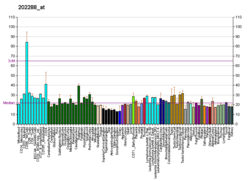The mammalian target of rapamycin (mTOR),[5] also referred to as the mechanistic target of rapamycin, and sometimes called FK506-binding protein 12-rapamycin-associated protein 1 (FRAP1), is a kinase that in humans is encoded by the MTOR gene.[6][7][8] mTOR is a member of the phosphatidylinositol 3-kinase-related kinase family of protein kinases.[9]
mTOR links with other proteins and serves as a core component of two distinct protein complexes, mTOR complex 1 and mTOR complex 2, which regulate different cellular processes.[10] In particular, as a core component of both complexes, mTOR functions as a serine/threonine protein kinase that regulates cell growth, cell proliferation, cell motility, cell survival, protein synthesis, autophagy, and transcription.[10][11] As a core component of mTORC2, mTOR also functions as a tyrosine protein kinase that promotes the activation of insulin receptors and insulin-like growth factor 1 receptors.[12] mTORC2 has also been implicated in the control and maintenance of the actin cytoskeleton.[10][13]
- ^ a b c GRCh38: Ensembl release 89: ENSG00000198793 – Ensembl, May 2017
- ^ a b c GRCm38: Ensembl release 89: ENSMUSG00000028991 – Ensembl, May 2017
- ^ "Human PubMed Reference:". National Center for Biotechnology Information, U.S. National Library of Medicine.
- ^ "Mouse PubMed Reference:". National Center for Biotechnology Information, U.S. National Library of Medicine.
- ^ Sabers CJ, Martin MM, Brunn GJ, et al. (Jan 1995). "Isolation of a Protein Target of the FKBP12-Rapamycin Complex in Mammalian Cells". J. Biol. Chem. 270 (2): 815–22. doi:10.1074/jbc.270.2.815. PMID 7822316.
- ^ Brown EJ, Albers MW, Shin TB, et al. (June 1994). "A mammalian protein targeted by G1-arresting rapamycin-receptor complex". Nature. 369 (6483): 756–8. Bibcode:1994Natur.369..756B. doi:10.1038/369756a0. PMID 8008069. S2CID 4359651.
- ^ Cite error: The named reference
pmid7518356was invoked but never defined (see the help page). - ^ Sabers CJ, Martin MM, Brunn GJ, et al. (January 1995). "Isolation of a protein target of the FKBP12-rapamycin complex in mammalian cells". The Journal of Biological Chemistry. 270 (2): 815–22. doi:10.1074/jbc.270.2.815. PMID 7822316.
- ^ Mitra A, Luna JI, Marusina AI, et al. (November 2015). "Dual mTOR Inhibition Is Required to Prevent TGF-β-Mediated Fibrosis: Implications for Scleroderma". The Journal of Investigative Dermatology. 135 (11): 2873–6. doi:10.1038/jid.2015.252. PMC 4640976. PMID 26134944.
- ^ a b c Cite error: The named reference
The neurology of mTORwas invoked but never defined (see the help page). - ^ Hay N, Sonenberg N (August 2004). "Upstream and downstream of mTOR". Genes & Development. 18 (16): 1926–45. doi:10.1101/gad.1212704. PMID 15314020.
- ^ Yin Y, Hua H, Li M, et al. (January 2016). "mTORC2 promotes type I insulin-like growth factor receptor and insulin receptor activation through the tyrosine kinase activity of mTOR". Cell Research. 26 (1): 46–65. doi:10.1038/cr.2015.133. PMC 4816127. PMID 26584640.
- ^ Cite error: The named reference
pmid15467718was invoked but never defined (see the help page).





